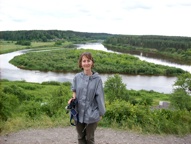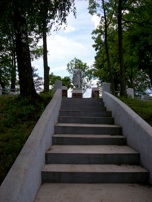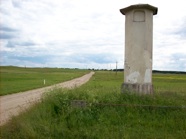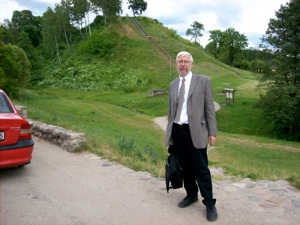Sixty-five years ago, on December 15, 1945, the Lithuanian town of Merkine was seized by a force or partisans and held for a day before being abandoned – the partisans had wanted to thumb their noses at the ruling Communists and paid for the action with the loss of five lives.
The action was described in detail by Adolfas Ramanauskas, code-named Vanagas, in his memoir Daugel Krito Sunu. In that book, written four years after the event, Ramanauskas named forty other partisans of the 200 who participated, and said he was the only one still left alive. Ramanauskas himself was betrayed in 1956, imprisoned and tortured and executed in 1957.

Lithuania is a small country with fewer degrees of separation than larger places, so I wasn’t entirely surprised to find a slight family connection. Ramanauskas had worked in the Alytus teachers’ college, where my mother was the director during the war. In the Alytus museum devoted to Ramanauskas, there is a photo of him standing behind her – she would go on to flee to Canada to raise three sons. He would fight in the forests and die.
Ramanauskas’s detailed description of this battle was the inspiration for one of the more important chapters in my novel. The battle is used in my book to show the high point of partisan strength and optimism, a peak from which the decline began quickly and continued until most of the partisans were killed or captured by the early fifties.
Merkine itself is a ghostly sort of town, a place that has fascinated me since I first visited it in the late eighties to hear the story of a priest who had been an agent for the KGB. Even then, the town seemed slightly behind the times, a place of sandy streets, picket fences, and dogs barking at sunset.
And much is very sad about the place, a hill at the confluence of the Merkys and Nemunas rivers that has been a defensive position frequently attacked, burned, and bombed over the centuries.

The hill has been inhabited for over ten thousand years, its fort burned by the Teutonic Knights in 1377. It received the right to rule itself as a city at about the same time as Vilnius, in 1387. King Vladislovas Vaza died there in 1648.
The city was burned in 1794, 1803, and 1822. The place was bombed during WW1. Over the centuries, Jews formed an important part of the town, the majority of the inhabitants at the centre. There were 3 synagogues and 145 stores, most of which belonged to Jews.
The centre of the city was bombed by the Germans in 1941 and about three thousand Jews murdered there (one Jewish source says 1,600) largely by Lithuanians.
I go to this town from time to time, once to visit my friends, the Jurasai, who have a house that overlooks the oxbow where the rivers meet. When the mist rises up at sunset, you can imagine all too well what the place must have been like a thousand years ago.
As I mentioned in one of my earlier posts, the church had a machine gun nest in the tower when Ramanauskas and his band attacked. The old Orthodox church, built by czarist authorities on the foundation of the burned city hall, is now a museum. Two medieval stone posts stand out in the fields, markers of the old town limits. Beyond the town are a German military cemetery, a Red Army monument, a monument to Soviet Partisans, and a monument to Lithuanian partisans.


This place seemed to represent best what Simon Schama said about the area in his book, Landscape and Memory:
There was, I knew, blood beneath the verdure and tombs in the deep glades of oak and fir. The fields and forests and rivers had seen war and terror, elation and desperation; death and resurrection; Lithuanian kings and Teutonic knights, partisans and Jews; Nazi Gestapo and Stalinist NKVD. It is a haunted land where greatcoat buttons from six generations of fallen soldiers can be discovered lying amidst the woodland ferns.
Such a melancholy site! But it keeps drawing me back. I’ll go there the next chance I get. It is a site that might be called the same as historian Timothy Snyder’s new book – Bloodlands.
